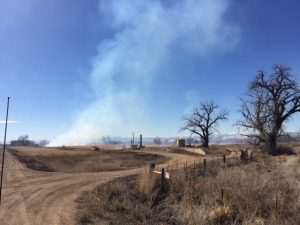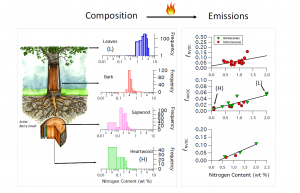13 October 2016
Fires fueled by grass, crops can produce dangerous air pollutants
Posted by dgaristo
By Dan Garisto

A crop fire in Aspen, Colorado. A new study finds emissions from the fire had high levels of nitrogen-containing volatile organic compounds (NVOCs), corresponding to the high nitrogen content of the crops. Credit: Matthew Coggon
Grass and crop fires can emit more of certain types of hazardous fumes than wood fires, a new study finds. Results from the study could help scientists better understand the dangers from fire emissions, allowing firefighters or individuals close to a fire to react more appropriately, according to the study’s authors.
The new research uses field measurements of fire emissions to show there is a relationship between harmful nitrogen-containing volatile organic compounds, or NVOCs, produced by a fire and the nitrogen component of a fire’s fuel.
Grasses and crops typically have higher nitrogen content than wood, so burning them produces more NVOCs, according to the study published in Geophysical Research Letters, a journal of the American Geophysical Union.
Due to their chemical composition, many NVOCs are harmful to human health and the environment—some, like hydrogen cyanide, are caustic to the lungs. Because of this, fires from particularly nitrogen-rich fuels might pose greater health concerns than those with less nitrogen content, according to Matthew Coggon, an atmospheric scientist at the Cooperative Institute for Research in Environmental Sciences (CIRES) at the University of Colorado Boulder, and lead author of the new study.
The new study also finds one type of NVOC used by scientists to track fire emissions is produced in much lower concentrations during wood fires, meaning some emissions could be going undetected by conventional methods.
“What we’re finding is that (biomass) emissions … can be attributed to what type of fuel they’re coming from,” Coggon said.
A burning mystery
In forest-fire prone areas, like Colorado, understanding what types of emissions are coming from fires is important for the health of local residents and firefighters who are frequently exposed to emissions.
In the new study, Coggon and his team compared emissions from residential wood-burning fires to those from crop fires to probe the relationship between nitrogen content and emissions. The researchers used a high-resolution mass spectrometer, an instrument that uses differences in molecular weight to measure chemical composition, mounted on top of a van to detect concentrations of NVOCs from fires.

The van the researchers drove around in with the mass spectrometer system visible on top. Credit: Matthew Coggon
The field results confirmed previous laboratory experiments that found in general, wood produces lower amounts of NVOCs when burned than do grasses or crops. Researchers had suspected that the difference in NVOC emissions was due to the difference in nitrogen content between types of fuels, but until this study, the relationship had only been investigated in laboratories. The new study confirms the relationship between nitrogen content and NVOC emissions in the field.
According to Coggon, these results have important implications. For example, a community downwind of a grass fire could be exposed to higher concentrations of health-impacting NVOCs than one downwind of wood stove emissions.
After investigating several fires, Coggon and his colleagues also discovered that their instrument was registering startling results: there was far less of one type of NVOC, acetonitrile, than expected. Scientists use acetonitrile, an NVOC that persists in the atmosphere for weeks or months following a fire, to detect emissions from biomass burning. Because it is used as a tracer for biomass burning, the researchers expected acetonitrile concentrations would be present in higher levels for all fires.
The researchers drove around Boulder and Aspen, Colorado to investigate this discrepancy. When they smelled or detected a fire with the mass spectrometer, they would park the van and measure its emissions.
Coggon and his co-authors found atmospheric concentrations of acetonitrile were approximately 10 times higher during crop fires than during residential wood fires. Although the researchers expected NVOC concentrations to be higher for crop and grass fires, they were surprised at the large discrepancy between acetonitrile concentrations.
“We noticed that the commonly used biomass burning tracer acetonitrile was not enhanced during measurements of residential wood burning,” Coggon said. “But it was enhanced when you went out and looked at a fire from an agricultural crop.”
The results put limits on the usefulness of acetonitrile as a tracer for biomass burnings, according to the authors. Although it is still an effective tracer for some fires, acetonitrile’s limited presence in emissions from low-nitrogen biomass burnings could mean that some fire emissions would go undetected, according to the study.
“We’ve been using atmospheric measurements of one compound, acetonitrile, for tracers of biomass burning emissions for many years,” said Steven Brown, a research chemist at the National Oceanic and Atmospheric Administration in Boulder, Colorado, who was not involved with this research. “This is a study that demonstrates nicely where that’s appropriate and where that’s not.”

This graphic displays how different parts of a tree with different nitrogen content produce different emissions when burned. Credit: Matthew Coggon
Suitable substitutes?
The new study confirms that fires from fuels with higher nitrogen content tend to produce more NVOCs, but scientists still don’t know why fires generated by fuels with the same nitrogen content produce varying amounts of certain NVOCs, like acetonitrile.
“My hypothesis is that some of that variability could be due to different amino acids that are present in different parts of a tree or a biomass,” Coggon said. “For our paper we couldn’t say anything about that because we don’t have the amino acid content in each of these different forms of biomass. It’s a hypothesis, but it is an interesting one.”
Moving forward, Coggon and his team will be using the Missoula Fire Sciences Laboratory—a center for fire research—to further investigate emissions from burning biomass.
“We’ll aim to understand the importance of fuel composition on the emissions,” he said.
—Dan Garisto is a science writing intern at the American Geophysical Union.


 GeoSpace is a blog on Earth and space science, managed by AGU’s Public Information staff. The blog features posts by AGU writers and guest contributors on all sorts of relevant science topics, but with a focus on new research and geo and space sciences-related stories that are currently in the news.
GeoSpace is a blog on Earth and space science, managed by AGU’s Public Information staff. The blog features posts by AGU writers and guest contributors on all sorts of relevant science topics, but with a focus on new research and geo and space sciences-related stories that are currently in the news.